How leaving our values unclear started breaking our culture at Kayako, how we fixed it and what we learned.
In the early days, a startup’s values and culture — the essence — is very much a reflection of the founding team. These values don’t need to be documented, they usually just are.
As new people join the team, the essence will transfer by osmosis. It’s in the air. The essence will be picked up through the sheer amount of time a small team will spend working on tough things together, and will evolve as new people contribute their own ideas and styles.
As the team grows larger and as things move faster, you can no longer rely on your values being passively picked up by others.
In this post we’ll talk about:
- The problems we faced not capturing our values sooner.
- What makes great company values great.
- Our first attempt at capturing values using a “Mars Group” (fail!).
- Our second attempt at capturing values (success?).
- How we are applying and scaling our values today.
“We were late capturing our company values and the cracks started to show”
At Kayako, there’s now 145 of us. Three offices. A large remote team. Distilling our essence and finding a way to articulate it is something we should have done a long time ago.
We started to feel the pain of not distilling our essence into a clear and repeatable format in various ways, including:
- Inconsistencies in style and attitudes between teams. With the absence of a clear and constant articulation of our core values, teams would incubate their own traits, which would trump the company’s.
- Speaking a different language. With these inconsistencies, we realised friction emerging in how we communicated with each other, whether that’s how feedback was given or how feedback was taken.
- Other people hiring the wrong kind of people. Without a crystal clear definition of what our values were, we were not equipping people to be able to hire consistently for values across the company.
- Recognitions and rewards started turning opaque. Without a crystal clear definition of what our values were, it became less clear why certain people were being recognised, rewarded or promoted.
At this stage, these issues were starting to impact our performance.
But if we left it unchecked? Our work would become less fun and less meaningful. We wouldn’t be able to attract and retain great people. We wouldn’t be able to build a great company.
We needed to get everyone back to our roots and capture the core essence of what made Kayako, Kayako. ASAP.
Values for your values: What makes great company values great
We’ve all seen company values before. Some we respect (Moz, TAGFEE). Some revolutionize something (Zappos). Some are so empty you can only laugh (guess which company’s values included the word Integrity?).
But what makes some company values effective, and others not? Why do some company values turn into a religion, but some end up as little more than wall decoration?
We spent some time researching and talking through this question with others. We found that some of the best and most effective company values had the following traits:
1: Values should be memorable and concise. If your values aren’t memorable or concise, they’re already handicapped. Values should be easy to communicate, easy to remember and will then be easy to incubate.
2: Values should be what you do, not just what you say they are. It doesn’t matter what you write down — the only values truth is in what you do, day in and day out. Not just what sounds cool or what looks good on the wall. We really like Netflix’s definition of what makes a true company value:
Actual company values, as opposed to nice sounding values, are shown by who gets rewarded, promoted or let go.
Values should be lived and breathed in the literal sense.
3: Values set expectations. Values make clear who will get hired, and for what. They make clear who will get rewarded and promoted, and why. Values are like APIs for people and culture, and in that sense make communication easier. They ensure compatibility and fit, set clear expectations of each other and remain consistent as you scale.
Values are like APIs for people and culture. They ensure compatibility and fit, set clear expectations of one another and remain consistent as you scale.
4: Values should be weaponizable. As we grow, there will be various demons any startup will face: glut, inertia and complacency. Our values should arm everyone with the weapons to fight these culture-rotting forces before they set in.
We picked up a nice anecdote from the book How Google Works about how Google’s weaponizable values are used on the ground:
[Eric Schmidt] was in an executive meeting in which they were debating the merits of a change to the advertising system, one that had the potential to be quite lucrative for the company. One of the engineering leads pounded the table and said, “We can’t do that, it would be evil.” The room suddenly went got quiet; it was like a poker game in an old Western. […] A long, sometimes contentious discussion followed and ultimately the change did not go through.
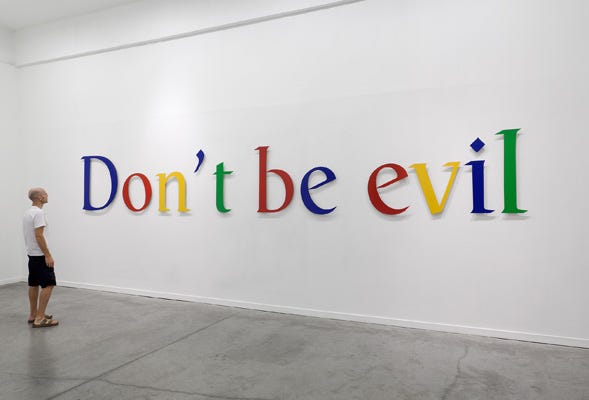
We found that some of the best company values were great levellers in this respect. Google’s “Don’t be evil” value is felt deeply by its employees, who use it to check their moral compass when making decisions, and who are empowered to call others out — no matter what their pay grade (prepare to be called out using your own values.)
Values should act as a touchstone that helps everyone keep a check on whether they are doing the right thing the right way. As Rand Fishkin from Moz puts it, “[our values are] an architecture for decision making.”
Without getting too tactical at this stage, another thing we noticed was that the best weaponizable values were written in a way that they could slot into day to day vocabulary, like in the Google anecdote above, or like our favorite example from the Atlassian values:
Don’t #@!% the Customer.
This ability to use the values verbatim increased the likelihood that they would feature on the ground, in conversations and in slide decks.
5: Values should be strong as hell. Startups grow, and hopefully grow fast. New people will join with their own quirks and cultural backgrounds. New stakeholders with their own agendas will be added. New customers will be won, bringing new demands. New priorities will be loaded onto the company’s agenda.
These are really powerful forces. Without a strong set of values to build your company culture on, these competing forces will start to chip at your company culture.
Startups will go really tough times — it’s almost a statistical certainty. When reading Ben Horowitz’s book The Hard Thing About Hard Things, it seemed like Ben’s startups had it tougher than most. But it was their strong cultural foundations and value system that saved them (and boy, did those folks’ values have to be strong.)
What makes values strong? We generally found this links back to 1: Values are what you do, not just what you say they are. Strong values come through in the company culture built on top of them. Values are strengthened by how much trust and confidence the team has in those values. Without trust or confidence, values are empty words.
6: Values should (mainly) be motivational. Great company values motivate people to go beyond, to step outside of a comfort zone and to accomplish something different, just as much as they prevent something or head off a bad force. Together, all of a company’s values differentiate you from another company.
There isn’t much point in documenting the kind of things good people will default to doing anyway. However, there are some exceptions: Google didn’t really think anyone would be evil, but acknowledged the forces of running a huge business and maximizing profit may start to compromise instinctive good values, so while “Don’t be evil” mat not necessarily be motivational, it was there to head off potentially distracting forces in the future.
Capturing our values: Attempt one
We followed a commonly held ‘best practice’ for our first attempt: form a “Mars group” and get together in room (in retrospect, we don’t feel this practice is best — read on).
With a few founding members and a new senior hire, we kicked off an exercise to paint a picture of where we would like to be in the next 1–5 years.
To capture our company values, we then asked ourselves this: What kind of traits will get us there, and what kind of traits would hold us back?
Or in other words, what does a high performance culture look like to Kayako?
We ended up with a long list of opposites: the positive traits that would help us fulfil our vision and achieve a high performance culture, as well as the antonym of those traits — the things that would hold us back.
Our thinking was that we would assess this world of traits, and draw from it a set of values to reinforce the good traits and prevent us from straying into bad ones (good traits -> ??? -> profit!).
To make sure we were being representative of the whole company, we invited a cross-section of the team (~20 people in total) to prioritize the all the traits that they felt were either most true to us today or most needed.
Surely, this would give us a fully representative true essence of Kayako today, the essence that differentiates us?
Not even close.
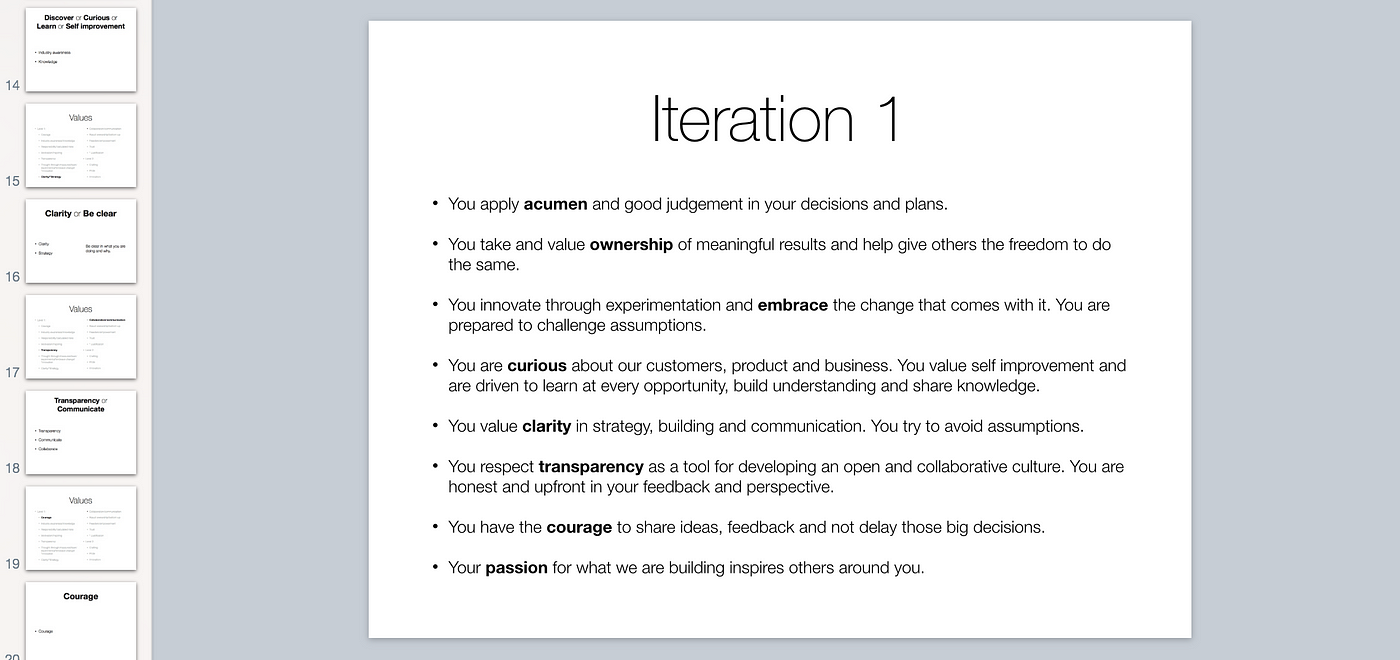
Acumen, ownership, embracing change, curiosity, clarity, transparency, courage and passion.
Meh. Shrug.
We couldn’t disagree with these values. They’re generally true, they’re generally positive. But they didn’t hit any of the things we had identified as what makes great company values great. They didn’t resonate. They didn’t connect. They didn’t wake us up.
We managed to create a set of flat, lifeless and generic values. But how, with so much of us put into the process?
We identified three missteps:
- The death-by committee approach. Great company values need raw passion, focus and emotion. By its nature, a committee compromises on all of these things. It turns out the “Mars Group” approach didn’t work.
- Focused too much on our current problems and not on our ambitions. We were too busy firefighting to really see past problems and see what could be. As a result, we were all focused on the negative things — things that needed to fixed, right now. We compromised on ambition and as a result, they weren’t motivational.
- We got too wrapped up in arguing what we were true to today, and what we weren’t true to. We spent a lot of time debating whether we could include values we weren’t particularly true to. We weren’t 100% transparent, so could we really make “transparency” one of our values?We realised it doesn’t matter, and in fact the values should guide everyone to be the kind of company you want to build, not just how things are today.
These were obvious missteps in hindsight — we had set ourselves up for failure. Time to rethink.
Capturing our values: Attempt two
This time, we did the opposite of a committee approach. We gave one person ownership of capturing our values. This was a leadership problem and needed leadership, not a committee.
Rather than getting everything on the wall — every possible positive value we currently do or would like to exhibit and narrowing things down from there — we took the time to sit back and really observe. Observe how we worked. How we problem solved. How we faced difficult situations. How we interacted with each other. What was there when things really worked out OK.
These are the questions we looked to answer, thinking that the answers would themselves capture our values:
- Why do people stay with Kayako and refer their friends to us?
- What are the traits and values we have been looking for — even if we weren’t actively aware of it — in people when hiring?
- When things haven’t worked out, why and what were the traits and values that were missing?
- When we’ve promoted people, why those people over others?
- When we really nailed something, what kind of values and traits were coming through?
- What kind of company do we want to be in the future?
We came up with lots of answers. Whatever came to mind when specifically answering these questions (ideally with plenty of colorful adjectives), we jotted down in a Hackpad.
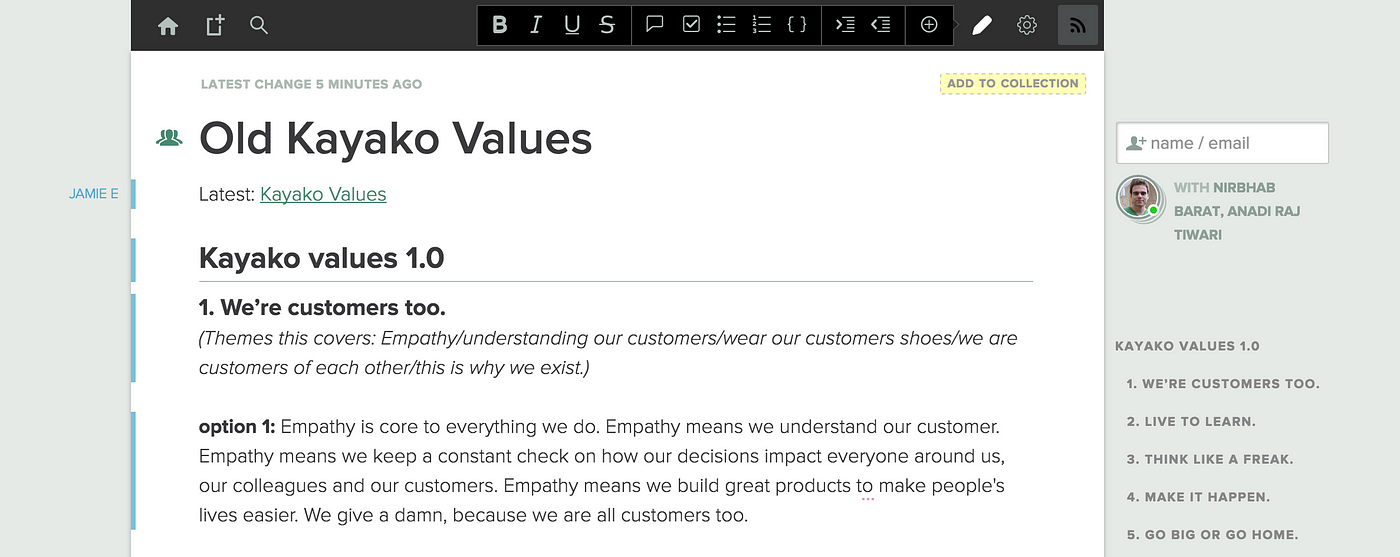
This process took about three weeks; enough time for enough scenarios and milestones to come up and go by, enough time to reflect and unpick things. I’m sure that if we were a smaller team, we could have accomplished this much more quickly.
These answers became our working collateral. The full universe of traits, behaviours and adjectives which we would now funnel and distil into our core values.
We iterated on these answers, reducing the various phrases into better, more concise phrases. With each iteration, we kept asking why: why did this trait come up? Why was it so material to success and tried to dig deep into the root.
Chris Moody blogged some key questions to ask when deciding whether avalue is worth capturing (or if it is more apart of your company’s vibe):
– Is this aspect of the company important to our long-term success?
– Does this aspect need to be maintained forever and is it sustainable?
– Does this aspect apply to all areas of the company and to all employees?
– Will establishing this aspect help us make important decisions in the future?
If the answer to yes is all of the above, you might have yourself a new value. If not, you’ve probably just observed a vibe in your company.
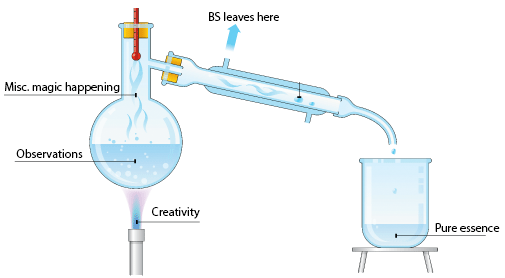
This process needs one person — ideally a founder, someone with your company’s core values in their gut — to be an all-absorbing sponge, and to take time out alone to reflect and apply a bit of creativity.
This really is a process of staring at a bunch of phrases and adjectives for a while, until a lightbulb lights up.
We distilled this language down into what became two of our values: Make it happen and Go big or go home.
We continued to iterate, simplify and refine the language we captured in our Hackpad. Shuffling things around, bucketing different phrases and traits together, etc.
We invited some select people to comment directly on the Hackpad with their interpretation of them after reading these early drafts. This was a very different approach to what we tried originally — we were getting feedback, but we were not forming committee. We continued this process until we got a consistent interpretation, which matched our original aim with the values.
We continued this process until the values clicked with all of us.
Here is what we came up with.
The Kayako Values
For each value, we chose not just a short memorable sentence or word, but also language describing how those values might be played out in real life.
We were inspired to use this ‘real life’ documentation of values style by the beautifully simple Buffer culture deck and the Genius.com “ISM”s. We felt it was important to provide real, concrete examples like this so that these values would be delivered clearly and with our ambiguity, across languages and functions.
Check them out on Slideshare:
Launching our company values
The first thing we did was prepare a slide deck, and not just because that is what the cool kids do. We needed to deliver these to the company and they needed to be delivered to everyone who joined Kayako.
It is critical to have editorial control over how the values were documented, paced and presented (to an extent). There needs to be a sense of occasion to them, if we are in agreement that the values are one of the most important institutions in your company.
The next thing we did was dedicate a company all-hands to these values.
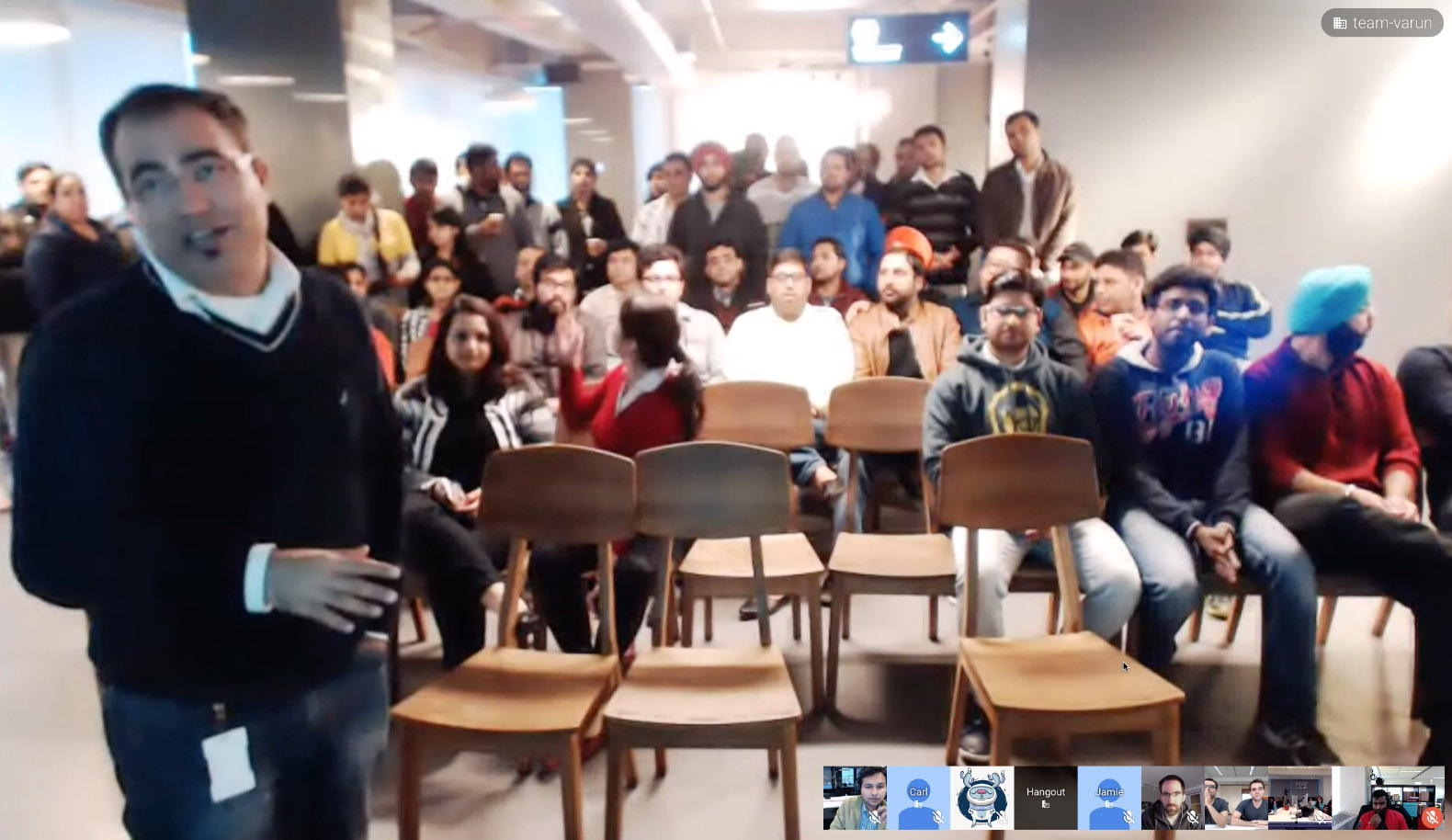
Step by step, we took the company through the mental journey we had been through to capture these. The observations that we made, the lightbulbs that went off, the ideas we threw away and the ideas that made it in, and why.
We took everyone through how we were already demonstrating these values today, and where we had work to do.
For us, the process was just as important as the output. We wanted to take everyone on the same journey (just with a few shortcuts which we discovered along the way).
Results so far? It is too early to tell. We know that everyone is excited, we are on the same page and that’s enough to get going with.
Scaling culture with our values
We don’t anticipate the fundamentals of our values changing much over time, but we are not freezing them.
There’s a reason why we put a v1.1 at the end of “Kayako Values” (probably the same reason why Buffer has a v0.4). We may iterate on the language over time, but what we are really eager to do is capture what we learn as we reach new levels of growth.
For us at Kayako, there is catch-up and a bit of a course correction to do. We can’t sprinkle values like pixie dust and say job done. The job has just started. As a founding team, we are going to put a lot of effort into coaching others about these values: getting them in to every day vocabulary, getting them into our goal setting and feedback processes. Bringing everyone back onto the same page, and ensuring our values are being consistently lived and breathed.
We would like to start capturing more of the Kayako culture and Eau de Kayako in a similar way to how Netflix did with their culture deck and how Valve did with their handbook. We think these make magical and tangible on-boarding tools.
We’ll also be looking at how we can incorporate values into our recognitions system. 7geese, a goals and feedback management tool, has an interesting take on recognition-via-values.

We are also exploring ways of really weaving in these values to our everyday surroundings. We really like the idea of creating some artwork to capture some of the values, like Facebook does. We don’t want to spoil them, though. There is a fine line between powerful and cheesy.
The most important thing we have to do, though, will be letting our values dictate how we we hire, promote and let go. There is no better communication or embedding of values — everything else discussed in this section is just micro-optimization by comparison.
Key takeaways
- Do this sooner rather than later. You don’t have one shot at this, so create your Values 0.1 sooner rather than later. Leave it too late and people will start to fall off the same page. It is critical you hire with aligned values at all stages. The longer you leave it, the easier it is to defer, smaller issues like the odd ‘wrong hire’ will start to compound and ultimately, the harder it is to revisit.
- Too many cooks spoil the broth. This will vary from team to team. It seems obvious in hindsight, but for us, trying to approach our values by committee was a terrible idea. It took that collective thinking and discussion process and then time and a single owner to flesh them out creatively.
- Follow up and give your values some meat. Earlier, we identified that great values are what you do, not just what you say they are. Values and leadership in general won’t work if people don’t believe. The only way people will believe in our values is if we live and breath them: hire by our values, let go by our values and reward by our values. Anything else is a bullet in the head for your values.
- Get wordsmithing help. This is a skill that is difficult to master — if you can, get the help of an expert when it comes to the final stages of refining the language in your values.
- Get someone to own it. Give this to the person who believes in this the most and will find the time to make it happen. It really does need creative alone time to get it right.
- It doesn’t matter if you are not 100% true to your values today. Your values should be ambitious. They have to paint the picture of the kind of company you want to be in the future, just as much as how things are today. Of course, don’t call a value a value if you can’t back it up at all (see #3).
- Don’t muddle your values and your vibe. Chris Moody already put this brilliantly. Unfortunately we came across Chris’ post after we made the misstep of capturing too many things as values (and we struggled to narrow them down).
Resources that helped us
We cannot give enough credit to the following companies, authors and speakers that inspired us with their own cultures, values and advice.
- Netflix and their culture deck
- Buffer and their values deck
- Atlassian’s punchy, weaponizable values
- MBA Mondays: Culture and fit by @fredwilson
- Hiring for culture fit by 7geese
- How we realigned our core values with our business by @WendyPFongfrom 7geese
- What we believe and why by @randfish from Moz
- Diving deep on TAGFEE by @randfish from Moz (can you tell we love TAGFEE?)
- A brilliant a16z podcast titled “Guiding Startup Culture — The Genius ISMs” with the Genius.com founders
- Startup Culture: Values vs. Vibe by Chris Moody
- How Google Works book by Eric Schmidt and Jonathan Rosenberg (full of anecdotes and advice which Eric and Jonathan picked up during their time at Google. Inevitably there is a lot of focus on people: hiring, retaining and scaling culture. It is packed with great advice on how to scale culture and embed your value system in everything your startup does.)
- The Hard Thing About Hard Things by Ben Horowitz (full of “no f’ing way!” stories about working through hard things in a startup, even when all seems lost. The thing that stood out to us was how often Ben thanked his startups’ strong cultural foundations to get them through tough times. Real, gritty and tangible stories to illustrate the power of a strong values system. In fact, it was probably this book that shoved capturing our own values to the top of our agenda.)
This post was originally posted Medium. Follow the Life at Kayako series to learn more about working at Kayako, our values and our culture.













